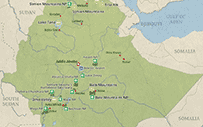Awash in cultural attractions and dramatic scenery, Ethiopia is far from ordinary. The wildlife here does not appear anywhere else on Earth. Memories of being surrounded by hundreds of gelada monkey with their swirling golden manes and bold red chests will last a lifetime. As will driving the continent’s highest road to see an Ethiopian wolf – Africa’s most endangered carnivore.

Pros & Cons
Wildlife
You’ll be looking for some of Africa’s rarest and most endangered animals in Ethiopia. In Bale Mountains, you’ll see the Ethiopian wolf, which is classified as the world’s rarest dog species. In Simien Mountains National Park, you might spot the Walia ibex, Africa’s only wild goat. Other endemics you might want to track down are the mountain nyala and Swayne's hartebeest.
Weather & Climate
The majority of Ethiopia’s top tourist sites have highland locations where daytime temperatures are around 24°C/75°F, and evenings are cool. Bale and Simien Mountains are a bit colder and the Rift Valley is a few degrees warmer. Temperatures don’t vary much throughout the year, but rainfall does. There is a distinct Wet and Dry season, and most precipitation falls between May and September.
Best Time To Visit
There isn’t really a bad time to visit Ethiopia. Wildlife viewing isn’t strongly dependent on season. If you intend to do some hiking or camping, it might be wise to avoid the wettest months (July and August). The Dry season months from October to April are the most favorable for outdoor activities but bear in mind that Ethiopia’s spectacular scenery is at its best after the rains from September to December.













